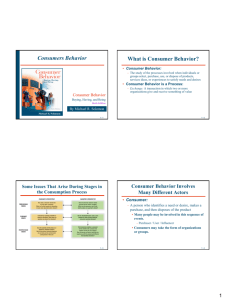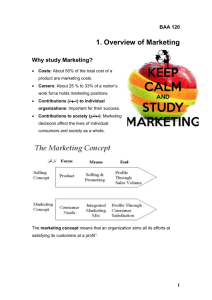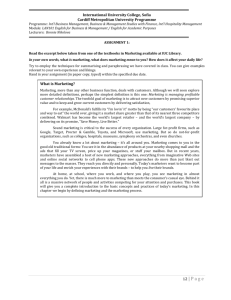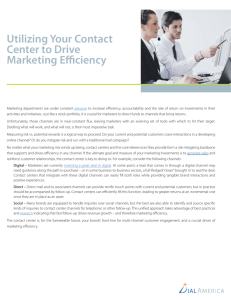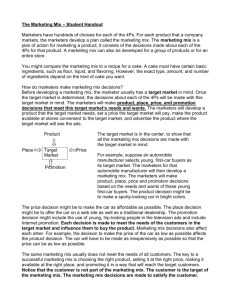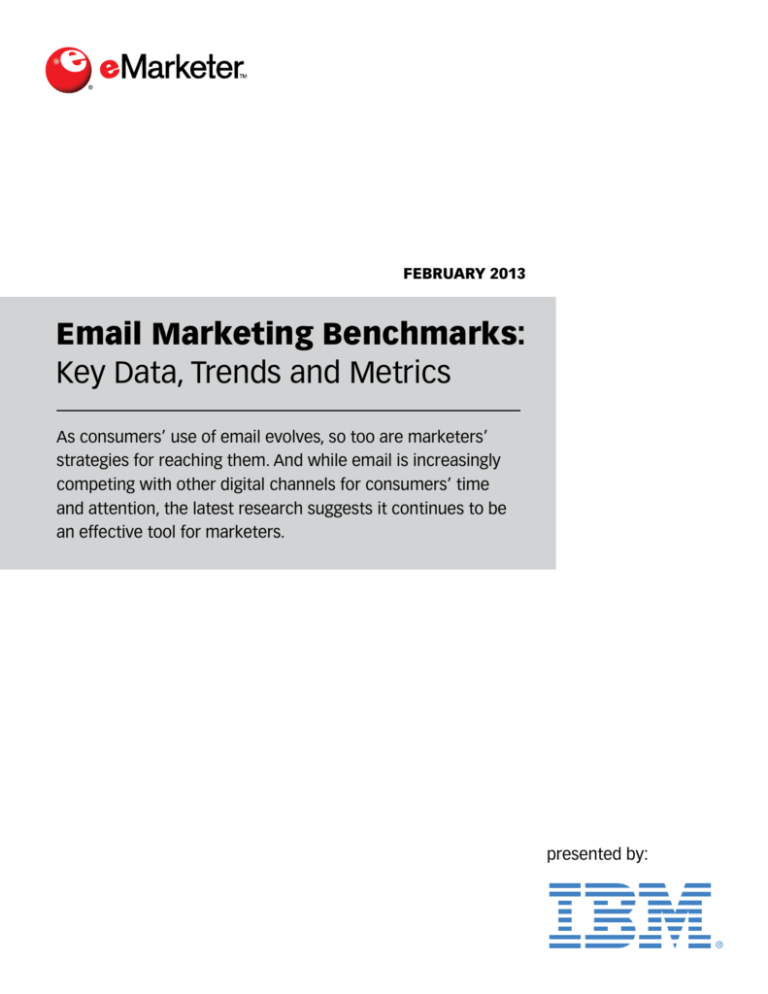
February 2013
Email Marketing Benchmarks:
Key Data, Trends and Metrics
As consumers’ use of email evolves, so too are marketers’
strategies for reaching them. And while email is increasingly
competing with other digital channels for consumers’ time
and attention, the latest research suggests it continues to be
an effective tool for marketers.
presented by:
Dear eMarketer Reader,
Email Marketing Benchmarks: Key Data, Trends and Metrics is one of
about 200 reports that eMarketer publishes yearly for our corporate subscribers.
These reports cover digital media, marketing and commerce across industries
and all digital channels, US and international. Each report provides an in-depth
understanding of specific markets and trends, offering unique analysis based on
the eMarketer method of looking at all available information. In short, they take
the vast amount of data eMarketer assesses and publishes daily, and put that
data into context for our clients.
We thank you for your interest in the Email Marketing Benchmarks Report and
IBM for being its presentation sponsor, enabling us to offer it to you today.
Please let us know if you have any questions or if you’d like to learn more about
gaining access to eMarketer through a corporate subscription.
Best,
Crystal Gurin
Vice President and Publisher
eMarketer, Inc.
75 Broad Street
Floor 31
New York, NY 10004
www.emarketer.com
cgurin@emarketer.com
215.629.1517 (direct)
215.266.1436 (mobile)
August 2012
Email Marketing
Benchmarks:
Key Data, Trends and Metrics
Lauren Fisher
lfisher@emarketer.com
Contributors
Tracy Tang
Executive Summary: Though email increasingly competes with other digital channels for consumers’ time and
attention, the latest research suggests it continues to be an effective tool for marketers.
141886
This report surveys the latest industry benchmarks for
email campaigns, covering open and clickthrough rates,
industry-by-industry breakouts, mobile statistics and more.
Email Marketing Performance Metrics in
North America, Q1 2010-Q1 2012
94.7% 94.8%
96.1%
95.0% 96.0%
95.7%
96.5% 96.3% 96.5%
22.4% 22.1% 22.0%
22.1%
23.3%
22.2%
23.8%
6.0%
5.2%
5.4%
5.1%
5.9%
5.2%
5.5%
Q1
Q2
Q3
Q4
Q1
Q2
2010
Non-bounce
Open rate
Q3
2011
24.8% 26.2%
5.2%
4.7%
Q4
Q1
2012
Clickthrough
Source: Epsilon and Email Experience Council, "Q1 2012 Email Trends and
Benchmarks," June 20, 2012
141886
www.eMarketer.com
The Email Audience
2
Email Marketing Benchmarks
3
Evolving Email Strategies
6
eMarketer Interviews
9
Related eMarketer Reports
9
Related Links and Information
9
About eMarketer
9
A number of trends are apparent: First, email is increasingly
accessed via mobile devices, creating both headaches and
opportunities for smart marketers. Second, personalization
has become far more sophisticated, with so-called triggered
emails continuing to raise the bar for timeliness and relevance
to consumers. Finally, the effect of “Big Data” is clearly being
felt as marketers use it to craft smarter, more targeted
email communications.
In light of these developments, marketers are evolving their
strategies to reflect the changing habits and expectations of
email users.
Key Questions
■
What are the latest email marketing benchmarks for common
metrics such as open rate and clickthrough rate?
■
How are mobile devices affecting email marketing?
■
How are email marketers using mobile optimization, data and
other marketing channels in combination with their email
marketing programs?
Digital Intelligence
Copyright ©2012 eMarketer, Inc. All rights reserved.
The Email Audience
email testing and marketing analytics company Litmus. “The
iPhone is what is taking over market share.”
More than nine in 10 adult internet users in the US
will send an email at least once per month in 2012,
according to eMarketer estimates. This vast audience,
representing more than three-quarters of the US
population, will continue to grow through 2016,
eMarketer predicts.
Open rate data from Knotice supports Jordan’s observation:
The iPhone and iPad accounted for the greatest share of
mobile email opens in 2011’s first half by a wide margin.
Such a skew toward iOS-based platforms is one marketers
should be acutely aware of, particularly when designing
emails that may require Flash, which does not work in the iOS
environment.
US Adult Email Users, 2010-2016
2010 2011 2012 2013 2014 2015 2016
Adult email users
(millions)
—% change
US Email Marketing Open Rate Share, by Device and OS,
H2 2011
% of total
172.6 178.3 183.2 188.7 193.1 198.3 202.0
3.4%
3.3%
2.7%
3.0%
2.3%
2.7%
Tablet
1.8%
—% of adult internet users 95.0% 95.0% 95.0% 95.5% 95.5% 96.0% 96.0%
—% adult of population
74.3% 75.9% 77.1% 78.6% 79.6% 80.9% 81.6%
Note: internet users ages 18+ who send an email at least once per month
Source: eMarketer, March 2012
137334
www.eMarketer.com
For most, email is a part of daily life. In a survey conducted in
February 2012 by the Pew Internet & American Life Project,
about 60% of US email users ages 18 to 64 said they had used
email the day before.
The mobile email population is sizeable and rapidly growing.
Network solutions provider Cisco Systems estimates there
will be 546 million mobile email users worldwide by year’s
end. By 2016, that number will almost triple to 1.41 billion. In
the US, eMarketer estimates, the mobile internet audience
will reach 115.8 million by year’s end, comprising 38.5% of the
population. By 2016, that number will increase to 60.5%.
Mobile use is already affecting email actions on the desktop.
Direct digital marketing solutions provider Knotice found
86.64% of US emails were opened on a desktop or laptop
computer in Q4 2010, compared to 13.36% of communications
opened on mobile devices. But by H2 2011, the portion of
emails opened on mobile devices had jumped to 27.39%.
Email Marketing Benchmarks: Key Data, Trends and Metrics
0.17%
Other
0.05%
Tablet
6.76%
Mobile
phone
20.63%
iPhone
15.69%
Android
4.69%
Palm
0.12%
BlackBerry
0.02%
Windows
0.02%
Other
0.09%
Desktop
72.61%
Total devices
Note: numbers may not add up to total due to rounding
Source: Knotice, "Mobile Email Opens Report," April 11, 2012
138883
www.eMarketer.com
138883
To complicate matters further, consumers aren’t just
accessing email using multiple devices. They’re also using
multiple accounts. Almost three-quarters of US email users
ages 25 to 40 managed their email this way, according to
February 2012 data from BlueHornet.
Number of Personal Email Addresses that US Email
Users Have, Feb 2012
% of total
4
5.8%
5+
6.5%
1
27.7%
3
21.0%
Some put the email open percentage even higher. “A third
of emails are now opened on mobile devices,” said Loren
McDonald, vice president of industry relations for digital
marketing technology provider Silverpop, in June 2012. “We
know mobile is growing and will continue to grow.”
One of the factors pushing mobile forward is the greater
support companies are giving to bring-your-own-device-type
programs. “Corporations are more open to employees using
things like the iPhone or the iPad [for managing their corporate
email accounts],” said Justine Jordan, director of marketing at
6.54%
Mobile phone
137334
Daily email use is even higher among mobile phone users.
Email technology provider Return Path found 88% of mobile
phone users checked their email via a handheld device daily.
iPad
Android
2
39.0%
Note: ages 25-40
Source: BlueHornet, "Consumer Views of Email Marketing" in conjunction
with Flagship Research, April 3, 2012
138707
www.eMarketer.com
138707
And if worldwide data is any indication of future growth, the
number of multiple email account users will continue to climb
Copyright ©2012 eMarketer, Inc. All rights reserved.
2
The Email Audience
steadily through 2016, along with the total number of email
users overall, according to the Radicati Group.
Email Users vs. Active Email Accounts Worldwide,
2012-2016
billions
3.38
2.17
3.84
3.61
2.32
2.46
4.34
4.09
2.61
Email Marketing Benchmarks
Email open rates in North America have risen
in recent quarters, but clickthrough rates (CTR)
have been slipping. Data from Epsilon and Email
Experience Council for the last two years showed
clickthroughs fell below 5% for the first time in the
first quarter of 2012.
2.76
Email Marketing Performance Metrics in
North America, Q1 2010-Q1 2012
94.7% 94.8%
2012
Email users
2013
2014
2015
96.1%
95.0% 96.0%
95.7%
96.5% 96.3% 96.5%
2016
Active email accounts
Source: Radicati Group, "Email Statistics Report, 2012-2016," April 10, 2012
139469
www.eMarketer.com
139469
Whatever device they are using, and however many accounts
they may be managing, it’s worth noting that internet users
still trust opt-in email messaging above all other forms of
advertising. Nielsen’s 2012 “Global Trust in Advertising and
Brand Messages” report showed 55% of internet users in
North America trusted advertiser messages from emails they
had signed up for, a level that trailed only recommendations
from people they knew, consumers’ opinions posted online,
and editorial content.
Consumers don’t just trust email; they look to it for purchasing
decisions. In a February 2012 ExactTarget study, 66% of US
internet users said email influenced them to make a purchase
decision. Similarly, BlueHornet found 51.7% of US email users
either somewhat or extremely likely to buy a product or
service from an email read on their mobile device. In addition,
Placecast found 20% of US smartphone owners had already
made a purchase from their mobile device based on an email
they had received from a merchant.
22.4% 22.1% 22.0%
22.1%
23.3%
22.2%
23.8%
6.0%
5.2%
5.4%
5.1%
5.9%
5.2%
5.5%
Q1
Q2
Q3
Q4
Q1
Q2
2010
Non-bounce
Open rate
Q3
2011
24.8% 26.2%
5.2%
4.7%
Q4
Q1
2012
Clickthrough
Source: Epsilon and Email Experience Council, "Q1 2012 Email Trends and
Benchmarks," June 20, 2012
141886
www.eMarketer.com
141886
One reason for the decline was the increased number of emails
hitting consumers’ inboxes. “We’ve seen an overall increase
in email volume from Q1 of this year vs. last year,” said Judy
Loschen, vice president of digital analytics at Epsilon. “There are
just a lot more emails going out and consumers are less likely to
click through if the email is not relevant and targeted.”
Automated email marketing, which sends messages upon
user-triggered actions such as completing a purchase or
downloading a trial, makes up only a sliver of total emails sent,
but posts a large contribution to clickthrough rate.
“Right now, we’re only seeing 2.5% of all emails triggered or
automated based on customer actions and preferences,” said
Loschen. Triggered emails saw an average CTR of 10.4%, more
than double the general CTR for Q1 2012, according to the study.
Marketers who take advantage of automation—which
includes everything from cart abandonment programs to
birthday emails—have seen conversion rates as high as 50%,
said Silverpop’s McDonald. “That small percentage of triggered
emails can drive 20%, 30% or 40% of the revenue.”
As a rule, user relevance is a significant driver of open and
CTR rates. Triggered automation mailings are designed to be
relevant to the user in real time. But not all efforts to make
Email Marketing Benchmarks: Key Data, Trends and Metrics
Copyright ©2012 eMarketer, Inc. All rights reserved.
3
Email Marketing Benchmarks
mailings relevant will necessarily increase engagement.
Research suggests the use of personalized subject lines, such
as those containing the recipient’s first name, for example, can
actually have a negative effect on performance. In a July 2012
benchmark study, email marketing company MailerMailer
saw significantly lower CTR and open rates (1.1% and 5.2%,
respectively) for personalized subject lines compared to
nonpersonalized ones (3% and 11.5%).
Metrics by Industry
The Epsilon/EEC data shows a wide variation in open and click
rates by industry. Loschen noted industries such as financial
services and travel are more inclined to use marketing
automation to manage real-time alerts and account-related
information, the kind of service-oriented messages that
typically see above-average open and clickthrough rates.
B2B
Tablets
iOS Android Total
8.79%
1.64%
Desktop
Total
10.43% 5.35%
0.13%
5.48%
83.70%
6.55%
1.55%
8.10% 1.43%
0.05%
1.48%
90.27%
Cable &
telecom
15.64%
4.78%
20.42% 6.62%
0.17%
6.79%
74.28%
Consumer
products
12.26%
4.17%
16.43% 4.01%
0.11%
4.12%
79.17%
Consumer
services
21.64%
7.24%
28.88% 5.88%
0.15%
6.03%
64.61%
Education
15.36%
2.56%
17.92% 7.15%
0.13%
7.28%
74.45%
Entertainment 16.34%
5.65%
21.99% 4.31%
0.25%
4.56%
72.77%
16.42%
4.29%
20.71% 3.96%
0.14%
4.10%
74.91%
Healthcare
8.24%
1.87%
10.11% 1.48%
0.03%
1.51%
88.30%
Hospitality
17.44%
3.86%
21.30% 6.35%
0.15%
6.50%
71.94%
Retail
17.19%
3.61%
20.80% 7.13%
0.19%
7.32%
71.58%
Financial
services
138884
Click Click-torate open rate
Business products and services
—general
94.3%
30.6%
5.5%
17.8%
Business publishing/media
—general
95.1%
20.5%
4.1%
20.1%
Consumer products—CPG
Consumer products
—pharmaceutical
97.6%
89.9%
15.3%
29.0%
5.7%
4.7%
37.3%
16.3%
Consumer publishing/media
—general
98.6%
15.1%
5.7%
38.1%
Consumer services—general
97.4%
25.0%
4.5%
17.9%
Consumer services—telecom
98.4%
18.2%
3.2%
17.5%
Financial services
—credit cards/banks
Financial services—general
Retail—apparel
95.3%
38.4%
5.4%
14.1%
95.1%
99.1%
33.2%
16.1%
5.7%
3.9%
17.3%
24.3%
Retail—general
98.4%
35.7%
5.4%
15.0%
Retail—specialty
98.4%
19.0%
2.4%
12.8%
Travel/hospitality—travel services
98.2%
36.2%
4.9%
13.4%
Source: Epsilon and Email Experience Council, "Q1 2012 Email Trends and
Benchmarks," June 20, 2012
141887
Association
Mobile phones
iPhone Android Total
Note: numbers may not add up to 100% due to rounding
Source: Knotice, "Mobile Email Opens Report," April 11, 2012
Email Marketing Performance Metrics in North
America, by Industry, Q1 2012
Open
Nonbounce rate
US Email Marketing Open Rate Share,
by Device and Industry, H2 2011
% of total
www.eMarketer.com
141887
The frequency with which stores share coupons and
discounts—both of which are of high value to consumers—
probably contributes to higher-than-average performance
for the retail industry. CPG marketers, who also frequently
distribute coupons through email, saw high clickthrough and
open rates in the first quarter of 2012.
www.eMarketer.com
138884
By contrast, the open rate share for retail and hospitality
emails skewed more toward mobile phones and tablets.
The Knotice data and Epsilon/EEC’s data suggest a possible
link between mobile mail and high open rate. But it’s important
to note that the higher rate may well reflect senders’ efforts to
optimize their messaging for mobile.
Mobile Email Access
Some marketers drag their feet on mobile email optimization
in the belief that consumers regularly triage—that is, manage,
organize and prioritize—their inboxes on their mobile
device and save non-optimized emails for later viewing on
the desktop. However, data from email service provider
BlueHornet suggests marketers should rethink that strategy.
Though the email service provider found about two-thirds of
US email users had used their mobile device to sort through
email before reading it on the desktop, 69.7% who received a
non-optimized mobile email deleted it and 18% unsubscribed
in response to one. Just 17.7% saved a non-optimized mobile
email for the desktop.
The share of messages opened on a mobile device vs. a
desktop varies from industry to industry, according to data
from Knotice. For B2B and healthcare messages, the open rate
share for emails viewed via desktops was far higher than for
other types of mailings.
Email Marketing Benchmarks: Key Data, Trends and Metrics
Copyright ©2012 eMarketer, Inc. All rights reserved.
4
Email Marketing Benchmarks
Behavior of US Email Users When They Receive a
Mobile Email that Doesn't Render Well, Feb 2012
% of respondents
US B2B and B2C Email Metrics, by List Type, 2012
Delete it
Prospect file
21.8%
12.9%
Clickthrough rate
8.6%
7.3%
Conversion rate (median)
1.2%
Open rate
69.7%
Unsubscribe
Acquisition cost (mean)
18.0%
ROI (median)
View on computer
17.7%
0.3%
-
$65.66
$52.5
-
B2C
22.9%
11.1%
Clickthrough rate
7.5%
5.3%
Conversion rate (median)
1.5%
Open rate
Read anyway
7.6%
File it
3.5%
Acquisition cost (mean)
ROI (median)
Don't know
9.4%
0.6%
-
$39.96
$16.5
-
Total
22.1%
11.4%
Clickthrough rate
7.7%
6.9%
Conversion rate (median)
1.5%
Acquisition cost* (mean)
-
$55.24
-
$11.00
Open rate
Note: ages 25-40
Source: BlueHornet, "Consumer Views of Email Marketing" in conjunction
with Flagship Research, April 3, 2012
142508
House file
B2B
www.eMarketer.com
142508
Other data suggests even fewer saves. Litmus found just 3.3%
of users had viewed an email in more than one environment.
For Knotice, that number was even lower: 2.39% in the first
half of 2011.
There’s even worse news for email marketers holding out on
mobile. Mobile analytics firm Prosper Mobile Insights found some
consumers moving away from desktop email viewing altogether.
Its June 2012 study showed 51.1% of US smartphone or tablet
owners viewed email only on these mobile devices. This was
more common among females (57.3%) than males (44.4%).
As mobile grabs a greater share of email opens, the decision
not to optimize email for mobile viewing is likely one that will
cost marketers. The same BlueHornet study as mentioned
above noted that 75.4% of US email users said a poorly
designed email negatively affected their perception of a brand.
Prospects vs. Customers
The type of distribution list used plays a role in determining
email benchmark measures. House lists, which the Direct
Marketing Association (DMA) defines as an email list of both
past and present customers generated from a company’s own
database, saw double the open rate and triple the conversion
rate of prospect lists.
Acquisition cost* (median)
ROI (median)
$28.5
0.4%
-
Note: *did not have a clear normal curve so the mean and median differ
substantially
Source: Direct Marketing Association (DMA), "Response Rate 2012 Report,"
June 14, 2012
141835
www.eMarketer.com
141835
The DMA data supports the common marketing belief that
it’s more cost-effective to cultivate existing customers than to
find new ones. The median return on investment for customer
emails was $28.50, compared to a mean customer acquisition
cost of $55.24.
Compared to business-to-consumer emails, business-tobusiness emails resulted in both a higher average acquisition
cost for prospects ($39.96 vs. $65.66) and a higher median ROI
for customer-facing emails ($52.50 vs. $16.50), an expected
finding considering B2B purchases tend to be costlier than the
average consumer buy.
Both B2B and B2C marketers have much to gain by breaking
through inbox clutter, but this could prove a more difficult task
for B2B marketers in the years ahead. Email research firm The
Radicati Group estimates the total number of business emails
sent and received daily worldwide will climb from 89 billion in
2012 to 143.8 billion in 2016. Consumer emails, however, will
decline slightly over this period—from 55.8 billion to 48.4 billion,
the company predicts.
Day to Mail
Additional findings from MailerMailer offer insight into which
days of the week marketers may have the best luck reaching
recipients. The firm found Sundays best for open rate (13.8%) and
CTR (6.7%). Tuesdays and Thursdays were also high-performing
days, with Tuesday boasting the second-highest open rate and
Thursdays the second-best CTR.
Email Marketing Benchmarks: Key Data, Trends and Metrics
Copyright ©2012 eMarketer, Inc. All rights reserved.
5
Email Marketing Benchmarks
Evolving Email Strategies
US Email Marketing Open and Click Rates,
by Day of Week, H1 & H2 2011
H1 2011
H2 2011
Open rate
Click rate
Open rate
Click rate
Sunday
10.8%
3.5%
13.8%
6.7%
Monday
11.6%
2.0%
12.7%
2.8%
Tuesday
11.5%
2.7%
12.8%
3.1%
Wednesday
10.2%
1.7%
10.9%
2.3%
Thursday
10.8%
2.7%
12.4%
4.0%
Friday
10.2%
2.2%
11.7%
3.0%
9.5%
2.2%
10.8%
3.2%
Saturday
Source: MailerMailer LLC, "12th Edition Email Marketing Metrics Report,"
July 25, 2012
143502
www.eMarketer.com
143502
Subject Lines
For subject lines, shorter was better for open rate. MailerMailer
found subject lines between four and 15 characters outperformed
longer-text subject lines. The firm’s study also calculated the
average CTR for each group, but it cautioned readers against
using these numbers as proper benchmarks without further data
and analysis.
As consumers’ use of email evolves, so too are marketers’
strategies for reaching them. Meanwhile, new tools have
created challenges as well as opportunities for marketers.
Three key areas that marketers are focusing on are mobile,
multichannel marketing and Big Data.
Optimizing Email for Mobile Devices
As of April 2012, 36% of emails worldwide were opened using
a mobile device, according to Litmus. Yet many marketers
haven’t moved to optimize their messaging for mobile.
StrongMail found that just 22% of marketers surveyed
worldwide were using mobile-optimized templates.
Ways in Which Email and Mobile Marketing Are
Integrated According to Business Executives
Worldwide, April 2012
% of respondents
Ways of integrating email
and mobile marketing
US Email Marketing Open and Click Rates, by Subject
Line Length*, 2011
No
57%
Yes
43%
Use of mobile optimized landing
pages/website
32%
25%
22%
Open rate
Click rate
4-15
15.2%
3.1%
16-27
11.6%
3.8%
Capture mobile number during
email sign-up
Use of mobile-optimized templates
28-39
12.2%
4.0%
Cross-channel email/SMS campaigns 21%
40-50
11.9%
2.8%
51+
10.4%
1.8%
Note: *number of characters
Source: MailerMailer LLC, "12th Edition Email Marketing Metrics Report,"
July 25, 2012
143503
www.eMarketer.com
143503
As marketers look to benchmark email campaign performance
off of these measures, they must take care to use their own
historical performance for context. In addition, they should
look to employ a mix of measures to build a complete view
of performance.
“There is some high-level gleaning one can do with standard
metrics, such as delivery rate, open rate and unsubscribes,
but the metrics that really matter are those that measure
effectiveness, like ROI,” said Michael Kelly, director of sales
and business development at email consulting firm Click
Mail Marketing. “You could have a compelling subject line
that is irrelevant to the offer inside, and you could have a
phenomenally high open rate, but it comes at a cost if you
don’t deliver on that promise.”
Integrated email and
mobile marketing
Note: among those who use mobile as a marketing channel
Source: StrongMail, "Mobile Marketing Survey 2012," May 23, 2012
140836
www.eMarketer.com
140836
Econsultancy and Experian Marketing Services found only
about a third of marketers and agencies planned to use
mobile-optimized email this year.
Marketers that are diving into mobile email optimization have
different goals and, as a result, their efforts represent different
levels of ambition and complexity. At the basic level, most
are using common optimization tactics such as reducing text
length, increasing font size and narrowing the template to fit
within the confines of a smaller mobile screen. Incorporating
fewer calls to action and designing messages to be more
touch-friendly are also best practices.
Silverpop’s McDonald cited one example in which the email
marketing company performed an A/B test for a client using
a mobile-optimized and a nonoptimized email. The company
saw a 64% higher CTR on the mobile version that was
optimized for font size, template width and touch.
“So many people are living on mobile devices, whether a
tablet or a smartphone, and their touch-based screens,” he
said. “But hardly any marketers design their emails for that
Email Marketing Benchmarks: Key Data, Trends and Metrics
Copyright ©2012 eMarketer, Inc. All rights reserved.
6
Evolving Email Strategies
finger. Redesigning with touch in mind won’t lead to a bad
experience on the desktop. All it’s doing is giving a bigger
target to the mouse.”
However, given the wide variety of mobile devices, some
marketers are taking a more advanced approach to mobile
email optimization by designing communications for each
unique mobile experience.
“Marketers need to actually change the content that’s being
displayed for each device,” said Jason Wells, CEO of call-tracking
and optimizations solutions company ContactPoint. “Behaviors
are so different from desktop to tablet to smartphone, and the
context in which they’re using these devices is too.”
Some marketers are turning to technology-based solutions,
such as responsive design, to automate the mobile email
optimization process.
Responsive design offers marketers an email template that
has the ability to detect both the device type and screen size
on which a user is opening an email. It then automatically
provides device-appropriate content and design. Technology
companies and travel companies appear to be the early
adopters of responsive design.
“Certainly, tech-savvy companies and companies whose
audience expects them to be on that trend [are using
responsive design],” said Jordan, whose company, Litmus,
offers this service. “I know British Airways is also using
responsive design. It makes sense to see folks in the travel
industry turning to this technology, because a huge portion of
their customer base is going to be on a mobile phone when
they’re traveling.”
Blending Email with Other Marketing Tactics
Mobile isn’t the only marketing tactic companies are blending
with email. In its “2012 Marketing Trends Survey,” StrongMail
found 68% of business executives worldwide planned to
integrate email and social media marketing this year.
Channels Business Executives Worldwide Plan to
Integrate Email with in 2012
% of respondents
Social media marketing
Mobile
44%
Search
17%
Display
Other
68%
14%
8%
Source: Strongmail, "2012 Marketing Trends Survey" conducted by
Zoomerang, Dec 7, 2011
134990
www.eMarketer.com
134990
The connection between email and social is the shared ability
to reach and engage consumers in a one-to-one relationship.
Email Marketing Benchmarks: Key Data, Trends and Metrics
“Email is what drives the beginning of any conversation,” said Ed
Kats, president of MediaWhiz, an online performance marketing
agency. “Social media is the natural execution of following up on
email content and continuing to have that conversation.”
It appears consumers are willing to continue that conversation
in social and even to engage their friends in the process.
BlueHornet found 37.3% of US email users shared emails with
their social networks.
However, social-email integration involves more than
using social to regurgitate email messaging. “What a lot of
marketers have done is take their standard email and slap it
into ShareThis for Facebook or Twitter, but there is absolutely
no reason for anyone to want to share that email content
outright,” said McDonald.
For social-email integration to work, McDonald said, marketers
need to focus on building email marketing campaigns from
the ground up, centering the email on a share-worthy action.
McDonald offered as an example the King Arthur Flour Co., a
CPG brand (and Silverpop client) that runs a holiday-season
contest promoting creative baking ideas. The company uses
email to encourage consumers to post images of their baked
goods on the brand’s Facebook page.
“What they’re doing is actually creating a standalone campaign
that has a compelling reason to motivate these people to share
what they’ve created,” said McDonald. “Consumers are excited
to show off [King Arthur’s] brand and what they made with it,
and they end up doing King Arthur’s marketing by sharing their
creations out into their Facebook streams.”
Click Mail Marketing’s Kelly often sees another form of
integration, where marketers pull user-generated content,
such as reviews, directly into their email text. “It’s one thing
to say, ‘Dan B. from Dallas loves our product,’ but it’s another
to actually see Dan B. from Dallas’ recommendation,” he said.
“Having that peer recommendation can drive trust, reduce the
friction of the sale and leverage the power of social marketing
within the email medium.”
Display advertising is also commonly integrated with email.
As of May 2012, 31% of companies polled worldwide by
Econsultancy and Responsys had already integrated display
ads with email and another 26% reported future plans
to do so. In addition, 85% of respondents felt the trend
toward integrating the two was significant to the future of
display advertising.
Using display for retargeting can be an effective purchase
reminder for consumers. Often tied to search or site activity,
it can also be combined with email to follow up on opens,
clicks and other email-initiated actions. At present, 24% of
companies worldwide are taking advantage of this integration,
using email behavior for display ad targeting.
Copyright ©2012 eMarketer, Inc. All rights reserved.
7
Evolving Email Strategies
Types of Information that Companies* Worldwide Are
Using to Target Their Display Ad Campaigns More
Effectively, May 2012
% of respondents
Type of "Big Data" Collected by US Marketers,
Feb 2012
% of respondents
Demographic data
74%
On-site browsing behavior
46%
Customer transaction data
64%
Referring URL
36%
Customer usage data
60%
Search query
35%
Location
34%
CRM data
30%
Social network ties and influence between customers and targets
33%
Customer mobile phone/device data
19%
Email behavior
24%
Traditional data
Explicit preferences about interests
20%
Digital data
Source: Columbia Business School and New York American Marketing
Association (NYAMA), "Marketing ROI in the Era of Big Data," March 4, 2012
Channel preference
137952
20%
www.eMarketer.com
137952
Note: n=125; *client-side or in-house marketers
Source: Econsultancy and Responsys, "Cross-Channel Marketing Report
2012," June 29, 2012
142678
Social media content created by customers and targets
35%
www.eMarketer.com
142678
Using Data for Email Segmentation and Targeting
The push to integrate email with other marketing channels
and the industrywide focus on Big Data has marketers looking
beyond standard demographic and geographic data to
behavioral and even purchase data.
“This year we have a lot of clients who are starting to see the
value of behavioral targeted messages,” said Epsilon’s Loschen.
“A lot of clients are weaving web analytic data back into their
database to enable them to trigger messaging based on what
they’re observing about an email recipient’s behavior.”
Click Mail Marketing’s Kelly has noticed the trend as well.
“Web behavior is extremely effective,” said Kelly. “You’ve got
all these different siloed off datapoints, whether it’s the web
analytics tool or CRM or call center or content management
platform, and it’s becoming very important for companies to
be able to put all that data in one place to effectively tease
out the right attributes of their audience to properly build
audience segments.”
The number of potential data sources at marketers’ disposal is
significant, and email is just one of many marketing channels
for which a company will use this data. A majority of US
marketers (74%) were tracking and collecting demographic
data, followed by purchase data (64%) and customer usage
data (60%), a form of behavioral data, according to a February
2012 study by Columbia Business School and the New York
American Marketing Association.
Email Marketing Benchmarks: Key Data, Trends and Metrics
“We’re looking at consumer behavior patterns and finding
their behavior through display or some other channel
response, whether it’s social or otherwise,” said MediaWhiz’s
Kats. “We’re then segmenting the data based on those
behavior patterns we see and what we know about them in
order to remarket to them more effectively.”
Even as marketers grow more sophisticated in their data
collection and usage, simpler forms of data, such as gender,
client status and demographics, retain their importance.
“Some of the most basic segmenting is about identifying
customers versus prospects,” said Kelly.
Kelly offered the example of a bicycle company segmenting
its audience by gender to send females a newsletter that
features a woman riding a bike, an image the recipient is
more likely to identify with. “Even those simple things move
you from a batch-and-blast approach to a more relevant
message,” he said.
Regardless of what data marketers use to segment their
audience, most would agree the goal remains the same:
creating a relevant, one-to-one marketing experience.
Though Kelly was quick to note that a one-to-one experience
is the Holy Grail of marketing, for email marketers, creating the
illusion of a one-to-one experience can be equally beneficial.
“One-to-one marketing doesn’t work with email,” he said.
“The ROI doesn’t pay out on so much unique identifying and
content creation, but the appearance of one-to-one marketing
is excellent. By taking that audience down to the lowest
subsegment and using dynamic content creation to appear
like you’re talking to someone, you can get fantastic ROI.”
Copyright ©2012 eMarketer, Inc. All rights reserved.
8
Digital Marketing
Made Easy
Cloud-based,all-in-onesolution
fordigitalpersonalizationand
marketingexecution
• Build,test,deliverandoptimizepersonalized
siteandemailcommunications
• Powerful,easytousesegmentation
Personalize
Execute
IBM Marketing Center
Analyze
• OptimizeresultswithA/BTesting
• Broadenchannelreachwithlisttargeting
• Intuitive,out-of-boxdigitalcampaign
managementandexecution
• Stateoftheartmarketingtracking&analytics
For more information on IBM Marketing Center
or to see a demo visit ibm.com/marketingcenter
©CopyrightIBMCorporation2013.IBM,theIBMlogoandibm.comaretrademarksofIBMCorp.,registeredinmanyjurisdictionsworldwide.Otherproductand
servicenamesmightbetrademarksofIBMorothercompanies.AcurrentlistofIBMtrademarksisavailableontheWebat“Copyrightandtrademarkinformation”
atwww.ibm.com/legal/copytrade.shtml(http://www.ibm.com/legal/copytrade.shtml).
The world’s go-to source for information on
digital marketing, media and commerce.
In the fast-paced digital world, it is neither prudent nor professional to
make business decisions based solely on a single source. eMarketer helps
companies minimize risk and maximize opportunity by providing…
COLLECTIVE WISDOM
COVERAGE
See all aspects of what is happening today in digital marketing, media
and commerce.
COLLECTION
Information is gathered from thousands of research sources around the globe
and hundreds of interviews with industry professionals a month.
CURATION
eMarketer sifts through the clutter, vets data for accuracy and distills information
to its essential intelligence – to save you time.
COMPARISON
Side-by-side source comparison charts display all relevant information on a
topic in one place.
CONTEXT
Focused, clear and concise, eMarketer reports provide a quick, complete picture
of fast-changing digital trends to make sense of complex issues.
CONVENIENCE
The information you need is accessible 24/7 from your PC, laptop, tablet or
smartphone—and downloadable in PDF, Excel, JPEG or PowerPoint formats.
CONFIDENCE
For 15 years, eMarketer has been recognized as the standard for media coverage
of the digital world—cited more than 4,000 times in the New York Times and
Wall Street Journal alone—and relied on by major brands and advertising
agencies around the globe.
COMPETITIVENESS
No one in business wants to be surprised, so see the trends coming and make
certain your organization always has the latest, most accurate and comprehensive
digital information available—with an eMarketer Corporate Subscription.
To schedule a conversation or customized
demonstration, go to eMarketer.com or call 212-763-6010


